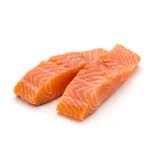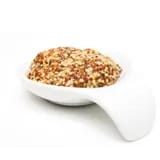Ingredients
Utensils
Stovetop, Frying pan
recipe

Step 1
If using frozen salmon, place it in a sealed freezer bag in a bowl of room temperature water for 10-15 minutes.

Step 2
Add a drizzle of olive oil to a pan on medium-high heat and cook the cherry tomatoes for 3 minutes. Cover and continue to cook on low heat for another 5 minutes.

Step 3
In the meantime, remove the defrosted salmon from the bowl of water. Heat a drizzle of olive oil in a pan on medium heat and cook the salmon skin-side down for 6 minutes.

Step 4
Remove the skin from the red onion. Cut it in half and then into thin slices.

Step 5
Flip the salmon and cook for 1 minute on each side. Set aside.

Step 6
Roughly break up the salmon into pieces using a fork.

Step 7
To make the dressing, mix the mustard with a drizzle of olive oil, and salt & pepper in a bowl.




Step 8
Add some arugula to a bowl, top with red onion, cherry tomatoes, and crumbled feta.

Step 9
Add the salmon and top with the vinaigrette. Season with salt & pepper to your taste and enjoy!
Personal notes
Add your own flavor!
Nutrition facts
Average estimated amount for one serving
| Energy | 484 cal. |
| Fat | 31 g |
| Carbohydrates | 7 g |
| Protein | 41 g |
| Fiber | 3 g |
Values are based on an average estimate for one serving. All nutrition information presented on Jow is intended for informational purposes only. If you have any concerns or questions about your health, please consult with a health-care professional.
On average, one serving of the recipe "Salmon & Cherry Tomato Salad" contains 484 Energy, 31 g of Fat, 7 g of Carbohydrates, 41 g of Protein, 3 g of Fiber.
Price per portion
| € | Nos recettes à -2 € par portion |
| €€ | Nos recettes entre 2 € et 4 € par portion |
| €€€ | Nos recettes à +4 € par portion |
Please note, the price above is dependent on your grocer and the available products in the grocery store you chose.
Scores


B Nutri-score
The Nutri-score is an indicator intended for understanding nutritional information. Recipes or products are classified from A to E according to their food composition to promote (fiber, proteins, fruits, vegetables, legumes, etc.) and foods to limit (energy, saturated fatty acids, sugars, salt, etc.).
B Green-score
The Green-score is an indicator representing the environmental impact of food products. The recipes or products are classified from A+ to F. It takes into account several factors on the pollution of air, water, oceans, soil, as well as the impacts on the biosphere. These impacts are studied throughout the product life cycle.
Retrieving reviews...



